Which is the Bengali’s best-loved pilgrimage centre? Had a public opinion amid the Bengali been organized then possible most of them unanimously would have picked out the Dakshineswar Kali temple, housing the homestead of Goddess Kali located in Dakshineswar, near Kolkata. The commanding deity of this temple is actually Bhavatarini, an aspect of Kali, meaning, ‘She who liberates her lifelong devotees from the ocean of existence’. It is believed that this is the sanctum where one of our best known mystic preachers of nineteenth century Bengal Sri Ramakrishna Paramahamsa caught sight of the holy spirit of the long-familiar Hindu divinity Kali Mother in its inimitable style.
Ramakrishna obtained his spiritual vision and preached the unity of all religions. It was the sheer dedication and indomitable spirit of Rani Rashmoni, an 19th century altruist, an ardent follower of deity Kali and of-course the benefactor that ultimately helped her well-wishers to found this spiritual shrine in 1855. The theological connection with Ramakrishna and Rani Rashmoni had made this shrine more spiritual and a place of bliss as well. Having the great faith on this sublime myth, millions of people not only form Bengali community but also from others visit this holy place from years together. Today we will get enriched to know prolific history of this holy temple and what to experience in this wonderful shrine as well.
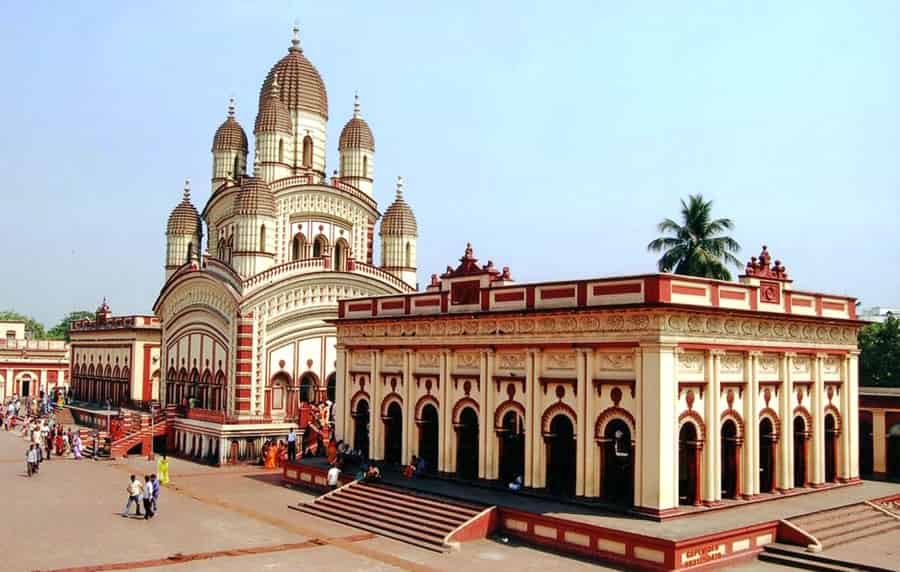
But before moving onto the historical development of Dakshineswar temple complex, let’s have a close look at the social backdrop of Bengal being ruled under the British at that time which actually stimulated the rising of such a shrine. Being grappled by the very first ardour of nationalism in the form of Sipahi Mutiny, the audacious Sipahis (soldiers) of Barrackpore revolted in 1857 on the line of river Ganges. The Dakshineswar shrine would be constructed on the bank of Ganges. The mutiny triggering a national outrage didn’t escape from the attention of the enlightened residents of the former capital of the country, Kolkata (second largest city of the British Empire only next to London). Amidst the philanthropists of the city, was the intrepid but deeply spiritual and devotional Rani Rashmoni who was the Groundbreaker, protesting soundlessly against the British rule.
- Suggested Tour: Devi Darshan Tour Packages
History of the Shrine
According to an article by J С Marshman published on in the January 1845 issue of Calcutta Review, Dakshineswar was a village Early 1800s and before. Surrounded the area with dense forest where the renowned temple stands today. In 1847, the philanthropist Rani Rashmoni decided to start on her pilgrimage to one of the consecrated Hindu places Kashi, in Benaras. As Kashi was far away from Kolkata, so it took her twenty four barges to sail carrying foods, armoured grads and her relatives as well. It is reportedly believed that the Goddess Kali came into her dream on the eve of the pilgrimage conveying her to build up a shrine of mother Kali on the riverside of Ganges in order to worship deity Kali. She was deeply impressed by this vision which prompted her to stop the pilgrimage and ordered her servants to donate all those carriages among the poorer. Coming back to home, Rani made up her mind to manifest worshipping the divine mother in the form of Goddess Kali. She called on her son-in-laws cum manager Mathura Babu to investigate the scope of building the shrine on the bank of Ganges.
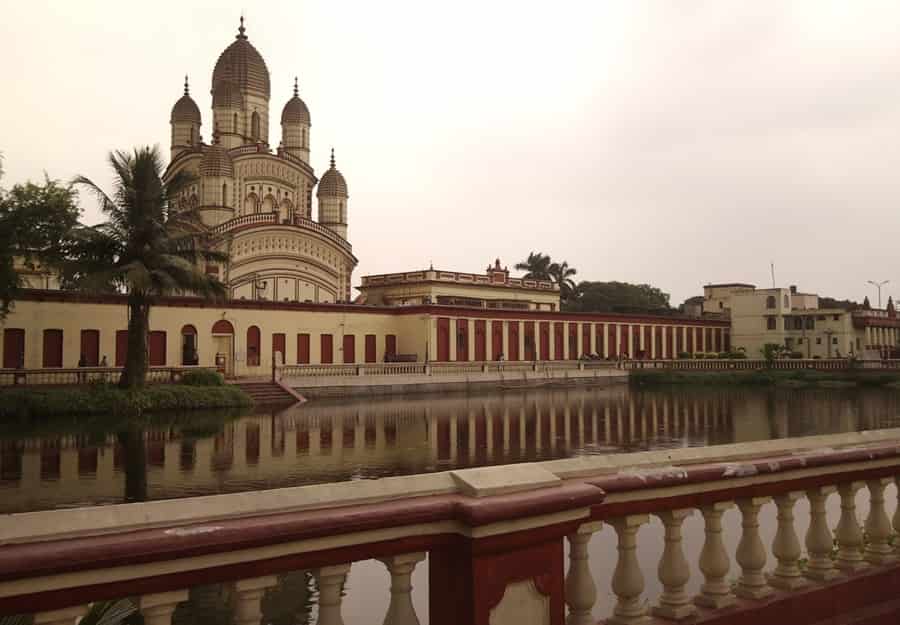
Finally on the east part of the riverside in Dakshineswar village, it was constructed after Rani bought 20 acre lands from the British Government. Somehow Rani finally materialised the last unfulfilled dream of her husband too. The elaborate temple complex housed the grand gigantic bathing places, temple of nine steeples, twelve identical Shiva temples, a Vishnu temple and a Natmandir (the dancing hall). Her dream came true on Snana Yatra day on 31 May 1855 after toiling for eight gruelling years and spending Rs. 9 lakh rupees of which Rs.2 lakhs was spent on the day of inauguration before the idol of Goddess Kali was set up within the shrine. Antecedently known as Sri Jagadishwari Mahakali, with Ramkumar Chattopadhyay (brother of Ramakrishna Paramahamsa) as the head priest, the shrine still today basks in the glory of the showcasing the a brilliant piece of architecture and a blissful place of loyalty, devotion and aesthetic beauty that engrosses visitants transporting to the spiritual word.
An interesting fact is being a low birth, neither Rani was entitled to worship any God or Goddess, nor could she own even a shrine as per the rules of regulations of the contemporary society. However, no social or any other bindings couldn’t ever impede Rani’s never-say-die optimism of installing of the idols of Gods and the Goddess in this shrine.
The Dakshineswar temple complex is an abode of joy and rejoices. The Deity is worshipped night and day in the various aspects as Father (Siva), as the Incarnation of Divine Love (Krishna), and again, as the Mother (Kali) of the Universe, deliverer of the universe.
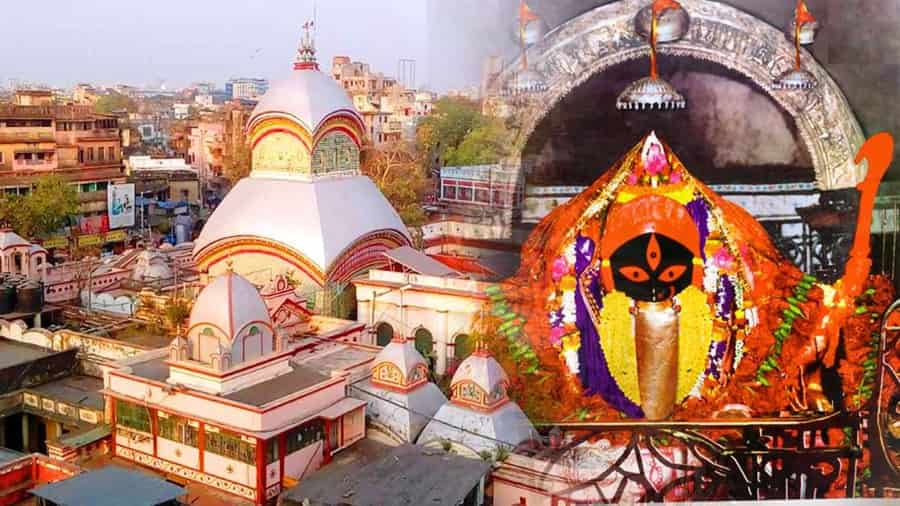
Shrines of Dakshineswar
The Navaratna (Nine Pinnacles) Temple of Goddess Kali
The river Ganges (Hooghly River) streaming beside the temple plays the significant role of beautifying the shrine to the visitors. The shrine entrance is a large portico crowned with many small peaks supported by many solid columns. Just outside the main entrance there are umpteen shops from where the visitants longing to worship Goddess Kali, collect the materials needed. The arboretum, a facility where trees and shrubs are cultivated around the temple, makes the ambience absolutely celestial.
On the centre of the grand temple complex lies the three-storeyed south-facing temple, principle attraction that holds nine steeples scattered in upper two stories and is flanked on a raised structure. It’s a large elongated building that follows the orthodox Bengali architecture with a flight of stairs, measuring 46 feet square that rises over 100 feet high claiming one of the largest temples of Kolkata. The prodigious Kali temple is believed to be one of the rare Indian temples, acclaimed across the whole world.
A thousand petalled lotus flower crafted entirely of silver in the sanctum sanctorum (Garbha Griha) serves the footstall of two idols-one is the Goddess kali, popularly known as Ma Bhavatharini standing on the chest of a lying Shiva, the second one. During the warfare between the Gods and demons, Goddess Kali let her tongue out to lap the blood of the infamous demon Raktabeej. That’s why she is seen with her tongue out.
Shrine of Shiva
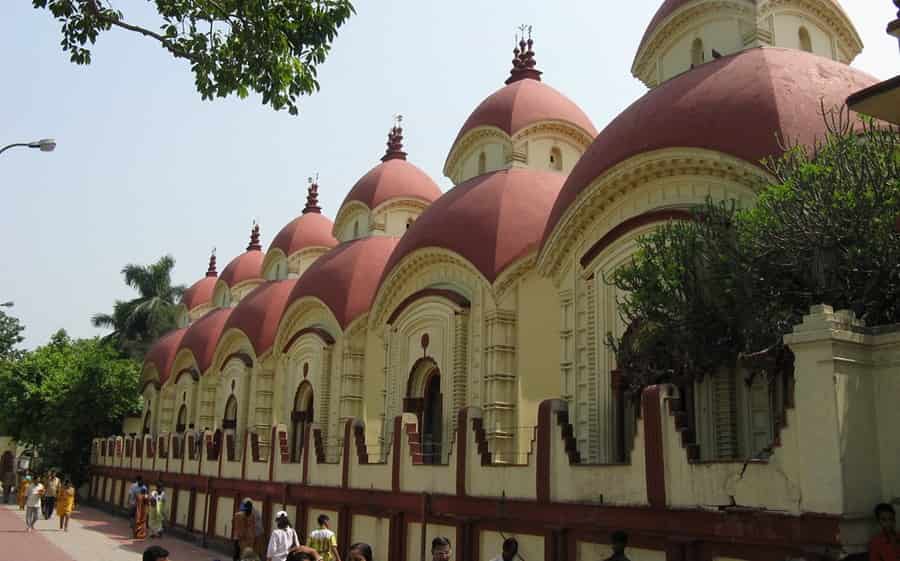
Close to the main temples is the row of twelve identical Shiva temples built facing the east in the typical eight sloped roofs (Aat Chala) Bengal architecture. The interior of the temples is decorated in white and black stone and each of the temples housing Shiva-lingas done in black stone. They are built on either side of the ferry Ghat on the Hooghly River keeping the six temples to the left and the other six to the right.
A narrow covered courtyard that bridges the sanctum also serves for the purpose of an audience-chamber. In front of the shrine lies there a spacious Dancing hall (Natmandir). Sri Ramakrishna is said to have contemplated here to reach enlightenment.
Temple of Deity Vishnu or the Radha Kanta’s Temple
The next best attraction is the Vishnu Temple (also known as Radha Kanta’s shrine). Located to the north-east of the grand temple complex with a flight of steps leading to the premises and the temple itself, supported by the large columns houses a silver throne over with a 21 and half inches idol of Lord Krishna and a 16-inch idol of Radha are mounted.
Some Other Holy Places to Visit to Dakshineswar Temple Complex
Natmandir: It is a 50 feet long and 75 feet wide open hall supported by sixteen pillars, with a roof located beside the shrine. Once upon a time, many religious discourses as well as spiritual songs were performed here. It is believed that Sri Ramakrishna used to pray an idol of Lord Shiva just above the Nat Mandir, before entering the Kali temple.
Chadni: The bank of the River Ganga flanked in between the series of Shiva Temples is the Chandni bathing place. It is just a flight of steps from the River Ganga where Sri Ramakrishna’s Vedantic guru Sri Totapuri climbed down from his journey.
Nahabat Khana: Of the two Nahabat Khanas in the temple complex, the one located in the southern garden is closed. The other is situated to the west of the Kuthi Bari and north of the Kali Temple. Nahabat, a mixed collection of many musical instruments were played in the ancient times while today the temple authorities allow only Dhak, Dhol and Kashi during the ‘Aarati’. Just below the Nahabat Khana was the restroom of Sri Sarada Ma when she stepped into Dakshineswar.
Gaji Tala: There is a pond called ‘Gaji Pukur’ having 260 feet length and 120 feet width to the east of the temple. Gaji Tala is a holy place to the north of that pond where Sri Ramakrishna explored Islam.
Kuthi Bari: In a close proximity from Gaji Tala, is the Kuthi Bari, positioned to the north of Ganga. Lord Hastings was the founder of that heritage building. It was a sojourn for Rani Rashmoni with her daughter and son-in-law while visiting Dakshineswar. At the ground floor of this abode stayed Sri Ramakrishna between the years 1855 to 1870. Now-a-days a police outpost is allotted here to look after the safety and security of the visitants.
The Holy Room of Sri Ramakrishna
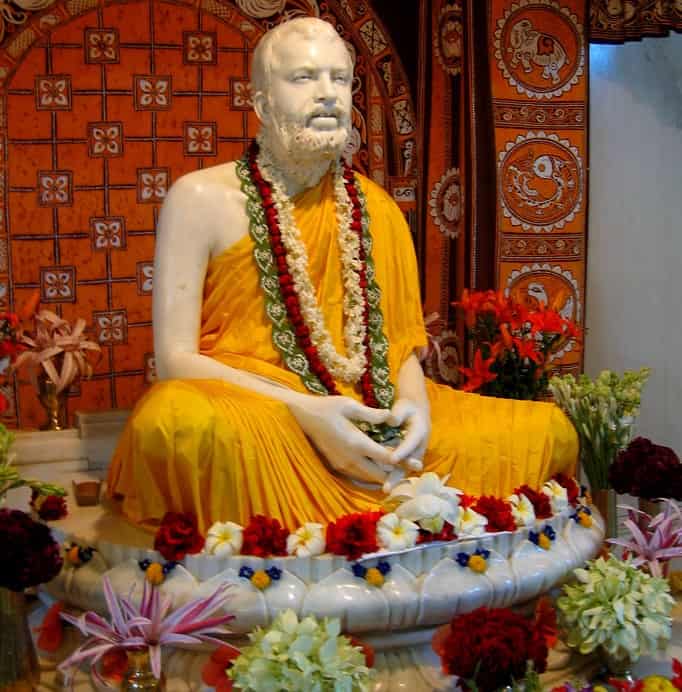
This is the notable room in the temple premises, in the North West corner where Sri Ramakrishna stayed on for the last 14 years of his life. Because of being the worshipper at this temple he used to stay in the temple premises. Today the visitors are allowed to get into this room.
The Panchavati: It is a spot for peaceful meditation constituted of the assemblage of five ancient trees. Sri Ramakrishna used to meditate sitting on the ‘Panchamundi (5 skulls) Ashana’ – a custom which is mandatory for the ‘Tantrika’ form of worship.
Nearby Attraction
Belur Math
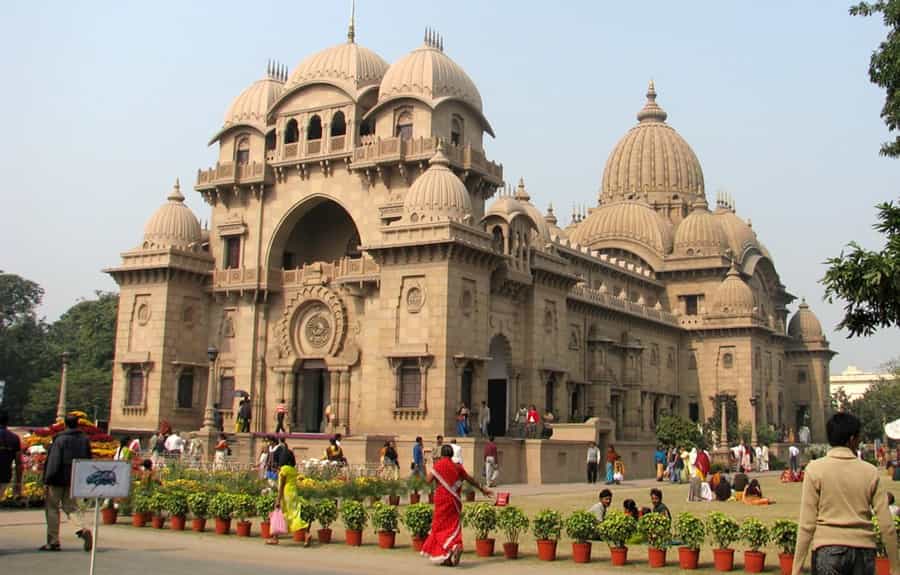
3km away from Dakshineswar temple is Belur Math serving a composed place of Pilgrimage. It also includes several temples and the headquarters of Ramakrishna Mission and Ramkrishna Math.
- Victoria Memorial (3.8 km)
- Esplanade (3.2 km)
- Howrah Bridge (2.2 km)
- Kalighat Kali Temple (6.9 km)
- Eden Gardens Stadium (2.3 km)
Location
Almost about 20 km from BBD Bagh, Dakshineswar Kali Temple is positioned alongside the Vivekananda Bridge north of Kolkata. If you come by train then board the Dankuni local from Sealdah main branch and get-off at the Dakshineswar station that is almost at walking distance from the temple. For more information, please visit the website mentioned below:
Prayer Time and Visiting Hours
Throughout the week and timings are as follows:
- 6:00 AM – 12:30 PM and 3:00 PM – 9:00 AM
Hotels Available near the Temple
- The Oberoi Grand Kolkata (1.8 km)
- Taj Bengal (5 km)
- Emerald Residency (6.2 km)
- Hotel 233 Park Street (3.2 km)
- The Park Hotel (2.4 km)
Apart from that various hotel are available to reside at an affordable cost for the tourists coming from outside. For detailed information please go through the link provided below:
Nearby Airport
- Netaji Subhash Chandra Bose International Airport (12.4 km)
Nearby Places to shop
- Esplanade (3.2 km)
- Shopping at Chowringhee (4.1 km)
- New Market (5.7 km)
- College Street (0.9 km)
- Bara Bazaar (1.7 km)
Nearby Places to Eat
- Tero Parbon (6.2 km)
- Oh Calcutta (0 km)
- 6 Ballygunge Place (5 km)
- Mithai (0 km )
- Aminia (1.4 km)
Nearby Railway Station
- Howrah Jn Train Station (2.5 km)
- Bandel Railway Station (39 km)
- Santragachi Railway Station (8.3 km)

 Call
Call WhatsApp
WhatsApp Enquiry
Enquiry